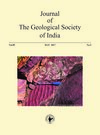Laws of Formation and Criteria for Predicting Nickel Content in Weathering Crusts of East Kazakhstan
DOI:
https://doi.org/10.1007/s12594-017-0650-7Abstract
The article considers from the theoretical point of new global tectonics the geological conditions of formation, peculiar features of material composition, and criteria for predicting deposits of nickeliferous weathering crusts of east Kazakhstan. According to geotectonic zoning, this territory includes geological structures of the Big Altai (BA), which is part of the central Asian mobile belt. The ore-controlling role is assigned to the area of global interaction of the Kazakhstan and Siberian paleocontinents during the stage of the Hercynian collision (í‘1-í‘3) followed by the formation of the Zaisan suture zone, the structure of which is represented by the Charsky-Gornostaevsky ophiolite belt (suture stitch). During the Hercynian cycle of tectogenesis, main gold fields of the regions appeared in the Zaisan suture (gold-quartz, gold-sulphide, goldlistvenite, etc.) in a collision situation, controlled by a system of deep faults of the crust and mantle type. In similar tectonic environment, large stockwork gold deposits were formed in Rudny Altai, north Kazakhstan, and other regions. During the Cimmerian cycle, the residual weathering crust deposits of Au, Ti-Zr, Ni-Co were formed in the region of continental rifting. The article emphasizes the spatial association of silicate cobalt-nickel deposits to the outputs of serpentinized ultrabasites of the Charsky- Gornostaevsky belt and provides a characteristic of the geological structure and material composition of nickel content in ores of the Belogorskoye and Gornostaevskoye standard deposits. Expansion of prospects depends on the possibility of growth of reserves of cobalt and nickel ores on the flanks and deep horizons of the known ore fields and search for buried deposits in prospective areas determined by geological and geophysical studies.Downloads
Metrics
Issue
Section
Downloads
Published
How to Cite
References
Big Altai (geology and metallogeny) (2000) Books 1-2. Almaty, Gylym, 1998.304 p.; RIO VAK RK, 2000.-400 p.
Diachkov, B.A., Kuzmina, O.N., Zimanovskaya, N.A. et al. (2015) Types of gold deposits in East Kazakhstan. Ust-Kamenogorsk: EKSTU, 204 p.
Dyachkov B.A., Mizernaya M.A., Mayorova N.P. et al. (2011) Geotectonic position and metallogeny of the Great Altai structures in the system of the Central – Asian Mobile Belt/New-Frontiers in Tectonic Research. General Problems, Sedimentary Basins and Island Arcs. Tech., Croatia, pp.73-92.
Ermolov, P.V. (2013) Relevant problems of isotope geology and metallogeny of Kazakhstan. – Karaganda: Publishing and Printing Center of the Kazakhstani-Russian University, 206p.
Gall, L., Williams, H.M., Siebert, C., Halliday, A.N., Herrington, R.J., Hein, J.R. (2013) Nickel isotopic compositions of ferromanganese crusts and the constancy of deep ocean inputs and continental weathering effects over the Cenozoic. Earth Planet. Sci. Lett., v.375, pp.148-155.
Kiselev, A.L. (2000) Gold-bearing weathering crusts of Kazakhstan. Almaty, 2000, 113 p.
Korobeynikov, A.F. (2011) Scientific basis for predicting-mineragenetic and exploratory research for noble-metal mineralization. Publishing House of Tomsk Polytechnic University, v.318(1), pp.14-22.
Marsh, E.E. and Anderson, E.D. (2011) Ni-Co laterite deposits: U.S. Geological Survey Open-File Report 1259, 9p.
Mysnik, A.M., Bochkova, O.I., Kravchenko, M.M. (2003) The types of weathering crusts in East Kazakhstan: formation of age-related boundaries, types of minerals. Geology and Protection of Mineral Resources, v.4, pp.30-37.
Quast, K., Connor, J.N., Skinner, W., Robinson, D.J., Addai-Mensah, J. (2015) Preconcentration strategies in the processing of nickel laterite ores. Part 1: Literature review. Minerals Engineering v.79, pp.261-268.
Rafailovich, M.S. (2013) Gold geology in Central Asia: the evolution of mineralization, metasomatic formation, explosive breccia. Almaty, 423p.
Ratié, G., Jouvin, D., Garnier, J., Rouxel, O., Miska, S., Guimarí£es, E., Cruz Vieira, L., Sivry, Y., Zelanod, I., Montarges Pelletier, E., Thil, F., Quantin, C. (2015) Nickel isotope fractionation during tropical weathering of ultramafic rocks. Chemical Geol., v.402, pp.68-76.
Reznichenko, A.V., Sizikova, N.V., Nazarenko, A. Yu., Nekhorosheva, E.V. (2012) Prospects of processing oxidized nickel ores in Kazakhstan. / Research in the mining and metallurgical industry: Collection of scientific works. Ust-Kamenogrsk: VNIItsvetmet. pp. 72-74.
Safonova I.Y. and Santosh M. (2014) Accretionary complexes in Asia-Pacific region: tracing archives of ocean plate stratigraphy and tracking mantle plumes. Gondwana Res., v.25, pp.126-158.

 Boris A. Dyachkov
Boris A. Dyachkov






